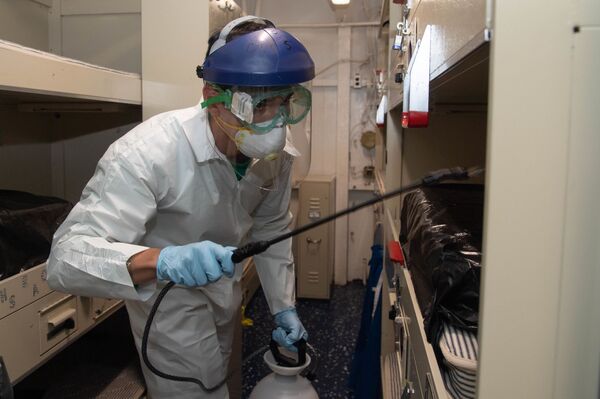The coronavirus outbreak aboard the USS Theodore Roosevelt has given epidemiologists a unique opportunity to study how the virus behaves in a closed, tightly-knit environment consisting of mostly young, healthy adults, Popular Mechanics has reported, citing Navy data.
As of the middle of last week, the Navy reported that some 777 members of the carrier’s 4,800-person crew have tested positive for the novel coronavirus since the first case was reported on March 22, with one crewmember reported succumbing to COVID-19-related complications last week.
However, scientists have found a curious anomaly regarding infection rates aboard the ship: unlike the general US population, where roughly 25 percent of those testing positive have proven asymptomatic, onboard the carrier that figure jumped to about 50 percent, with most of these said to be men and women with no prior reported health problems under the age of 30.
At the same time, the Navy’s request for a thousand crew members to submit swabs and blood tests to help “connect the dots” on transmission could help epidemiologists better understand how the virus is spread, and how long an immunity may take to develop.

Speaking to the Washington Post, UCLA professor of epidemiology and medicine Timothy Brewer said the USS Theodore Roosevelt’s confined spaces and accounting for where sailors are at all times could help give scientists a better idea of exactly how transmission is facilitated and hence, how it can be reduced if the findings can be extrapolated to the outside world.
“The more and exact data you have, the better you can interpret it and come up with conclusions,” Dr. Brewer stressed.
Dr. Albert Ko, chair of Yale’s School of Public Health, said that when it comes to the young sailors aboard the carrier, studying the spread of the coronavirus in this controlled environment could help fill the “knowledge gap” that presently exists regarding what impact the virus has on young people, and what role they may play in spreading it. “A lot of plans are based on testing people who are sick, isolating them, tracing their contacts and quarantining them,” Ko said. “If there is a lot of asymptomatic transmission, then it makes that strategy much more difficult,” he added.
The Navy expects its testing to take place over the space of a week, with the light medical probing accompanied by questionnaires on sailors’ living conditions and any potential symptoms they may have.

Another potential boon coming from systematic testing of the sailors aboard the USS Theodore Roosevelt are any revelations it may have regarding just how widespread the virus actually is.
Last week, antibody testing by researchers from the University of Southern California and the Los Angeles Country Department of Public Health discovered that coronavirus infections may be far more widespread than previously estimated, a conclusion which, if extrapolated, could mean that fatality rates are far lower than previously feared.
According to data obtained from drive-thru antibody testing carried out between April 10-11 across six LA Country locations, approximately 4.1 percent of the adult population may have an antibody to the virus (i.e. a protein in the blood produced in response to the pathogen). According to the data, when accounting for the statistical margin of error, between 221,000 to 442,000 adults in LA County may have already been infected – an infection rate that’s about 28 to 55 times higher than the mere 8,000 or so confirmed COVID-19 cases reported at the time the study was done.
Scientists have urged caution against making broad, sweeping conclusions, but if the LA Country results are extrapolated nationwide, that could mean that COVID-19’s lethality is far, far below the estimated 17.7 percent reported based on Johns Hopkins’ latest figures.



